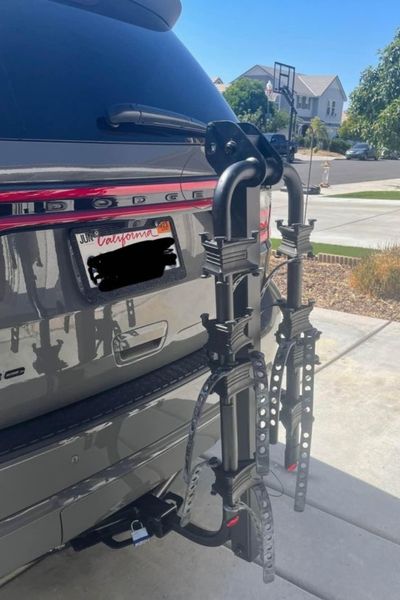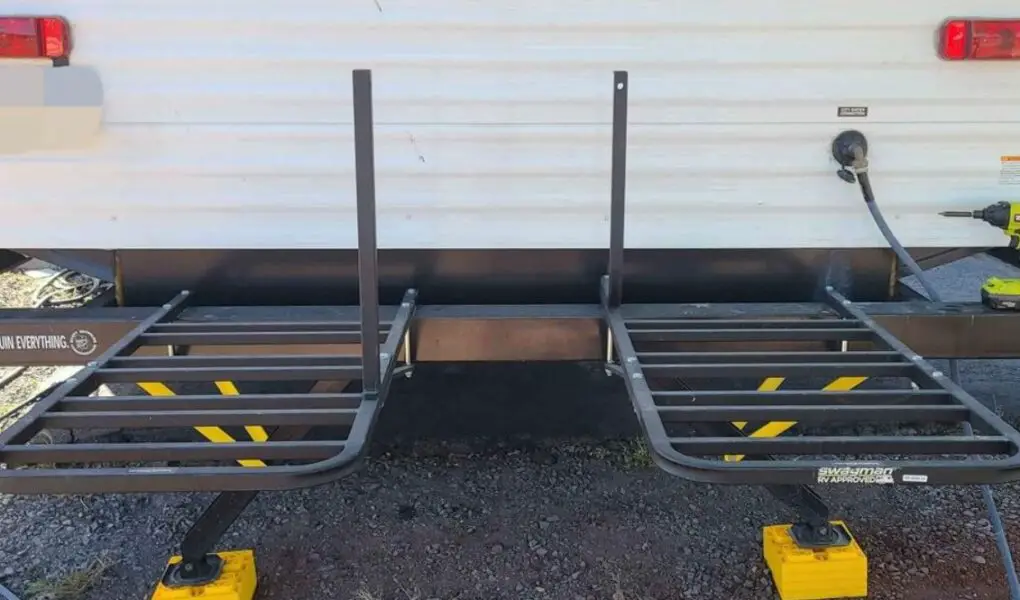Bike racks come in a number of different styles, configurations, sizes, and capacities. Regardless of whether you are using your bike rack for a quick weekend outing, or a cross-country RV trip, it is important to not overload it with too much weight. If the rack is overloaded it will eventually fail to lead to damage or destruction of your bikes and perhaps even damage or injury to you, your vehicle, and surrounding traffic.

While it is important to know and stay within the weight limits of your bike rack, it is also very important to know the limits of the supporting structure under your bike rack. Overloading that structure can also lead to serious problems down the road. In this article, we’ll take a look at how much weight common types of bike racks are designed to carry as well as some of the limitations of the underlying structures you’ll be attaching them to.
General Bike Rack Limits
When looking at general bike racks designed to carry a standard single-person adult-sized bicycle, most manufacturers assume a maximum weight of around 35 – 40 lbs per bike. This is a typical weight for an inexpensive bike built with standard steel components. Given that, if you are looking to estimate the weight a typical 3-bike carrier can carry you can expect it to be around 105 lbs – 120 lbs.

This is not always the case. Some manufacturers will specify a per bike weight as well as an overall maximum which is usually somewhat lower than the sum of the bike capacity by bike weight. Actual weight limits will vary depending and the manufacturer and rack style. Most manufacturers will publish the weight limits of their racks on the specific model’s web page or owner’s manual.
Types Of Hitch Racks
Horizontal frame mount – Horizontal frame mount racks like the Swagman XP5 or Swagman Trailhead 4RV are designed to attach to a standard 2” hitch receiver while holding the bikes by the top cross frame rail. Both of these racks are designed to carry bikes up to 35 lbs. However, they both have a maximum capacity of 100 lbs. This discrepancy is likely due to the leverage forces on the rack as you add more bikes further away from the receiver.
Horizontal Platform Mount. Horizontal platform mounts like the Swagman XTC4 also attach to the vehicle via a 2” hitch receiver. They carry the bikes with a more elaborate and stable set-up than with a frame mount rack. This makes them less susceptible to lever forces which can limit weights on a fully loaded frame mount rack. This particular model specifies the same 35 lbs per bike but does not have a maximum loaded limit of 100 lbs.
Horizontal Swing-out Frame Mount – Horizontal swing-out frame mounts like the Yakima Fullswing are standard frame mounts with an additional hinge mechanism that allows you to swing the rack out of the way. These are ideal for vehicles like SUVs and Crossovers which have a liftgate rear access. The swing-out feature allows the rack to be dropped out of the way (empty, or with bikes loaded) so the lift gate of the vehicle can clear it. This particular rack holds four bikes at 40lbs/bike. There is a 150 lb total weight limit.
Horizontal RV Bumper Rack – The Swagman RV Bumper Rack 4 is an example of a bolt-on RV bumper bike rack. This particular model holds up to 4 bikes at 35lbs/bike. That gives it a total limit of 140 lbs. Note the manufacturer specifies this unit only be used on fully welded steel bumpers. See the section Other Things to Consider below for an explanation.
Vertical Hitch Mount – Vertical hitch mounts like the Alta Sixpack, NSR Six Bike Straight, and Hangtight 6 work similarly to frame mounts by mounting in a 2” hitch receiver and holding the bikes in a row. They differ however in that they hold the bikes vertically by the wheels. They also line them up across the back of the vehicle instead of in a row away from the vehicle. This makes them all the same distance from the hitch which minimizes the lever effect of the weight on the rack. Weight limits range from 37.5 – 60 lbs per bike depending on the model and options.
Vertical Hitch Bike And Kayak Rack – Yackups make a series of vertical hitch racks which are capable of carrying kayaks, surfboards, paddle boards, and bikes. Their website lacks specifics on maximum weights but they do state their racks require frame-mounted 2” hitch receivers for installation. Given their design and suggested uses with kayaks up to 12’ they should easily hold a couple of hundred pounds.
Rooftop Bike Racks – Rooftop bike racks usually rely on a rail and crossbar system for mounting. That system, or parts of it, may be part of your vehicle or it may be added completely separately if your vehicle did not come equipped with the rails or cross bars. The rail and crossbar system is usually designed to haul more than bikes.
For example, the same rails and cross bars can usually be adapted to use kayak mounts, rooftop carriers, cargo boxes, coolers, and even tents. Specific bike mount attachments will have weight limits in the 35 – 60 lb range. The overall limit of the rack will be the maximum the roof, rails, or cross beams can support, whichever is the weakest link. That is typically the roof in most modern cars. Expect the maximum weight a roof can support to be around the 200 – 300 lb range. Check your vehicle owner’s manual for specifics.
Boot Mounted – Boot, or trunk-mounted, carriers come in frame mount as well as platform styles. Regardless of the style expect these carriers to have a 30 – 40 lb per bike weight limit. Note that these can be vehicle specific so always check that the rack you are considering will work with your vehicle.
Truck-mounted Bike Racks – Truck-mounted bike racks make up a broad range of products for carrying bikes in or on the bed of a truck. These products include simple axle clamps, tailgate racks (or these), or something super beefy like these. Most of these are far stronger than the weight of the individual bikes they are designed to secure and they rely on the structure of the truck for the majority of the support so they typically don’t list maximum weights.
Spare Tire Bike Rack – Spare tire bike racks use a clamping mechanism to attach to a rear-mounted spare tire. That mechanism can vary from systems that attach to the tire itself to others that attach to the rim or tire mounting bolts. Once attached they can be used to support the number of bikes the specific model was designed for. A good example of this type of rack is the Yakima SpareRide. 35 – 40lbs/bike is the typical weight limit for this type of rack.
RV Ladder Bike Rack – RV ladder racks are bike racks that secure the ladder leading to the roof found on many RVs. One of the most popular models out there is the Camco RV Ladder Rack. These can carry up to two bikes and they are extremely easy to install and use. These units have a 60 lb weight limit.
Travel Trailer A-Frame Bike Rack – A-frame, or tongue bike racks, attach to the front frame rails of a travel trailer allowing bikes to be mounted over the tongue-mounted propane tanks. These have the advantage of being a sturdy option for carrying two bikes in a location that would otherwise go unused.
Other Things To Consider
The maximum weight the bike rack can hold is only one part of the puzzle in determining if you can safely travel with your bikes. Many of these racks attach to things that were not necessarily designed to carry bikes, handle constant loads, or deal with the stresses the added loads can impart on your vehicle as you travel down the road. A good example is the 4” rear bumper found on many trailers.
There are several manufacturers that produce bike racks that bolt directly to these bumpers. While some specify their products to be used only on steel, fully welded bumpers may still not be a good idea. There have been several documented cases of catastrophic bumper failures due to the use of bike racks mounted to 4” steel fully welded bumpers.
The issue is that these racks add rotational weight to the bumper which stresses and fatigues the welds over time. The bouncing motions caused by the trailer moving down the road amplify those forces and can cause the forces to be applied in both rotational directions.
This is akin to taking a piece of metal and bending it back and forth over and over. If you do that, the metal will eventually fatigue and break. Also, be wary of spare-mounted bike racks when the spare is mounted to the bumper. If possible, it’s generally better to avoid bumper-mounted racks in favor of a frame-mounted receiver with a receiver-based rack.
The same issues can also be true for ladder racks. RV ladders are designed for the weight of a single adult person to occasionally go up and down the ladder. They are not designed for the constant stresses of a 50 – 100 lb load bouncing up and down on them for hours on end. If you choose to use a bumper or ladder rack it is best to inspect those parts regularly to make sure the forces caused by the bike rack are not causing damage.
A-frame bike racks can also cause issues. Adding a bike rack and bikes to the front of the trailer will increase your tongue weight. Exceeding the tongue weight rating of your hitch system can cause a hitch failure. Excessive tongue weight can also cause stability issues as you tow. While the added weight of the bikes may seem insignificant, it’s important to note that it’s there. If it does cause a problem with your setup, it is easily compensated for by shifting weight inside the trailer from the front to the rear.




